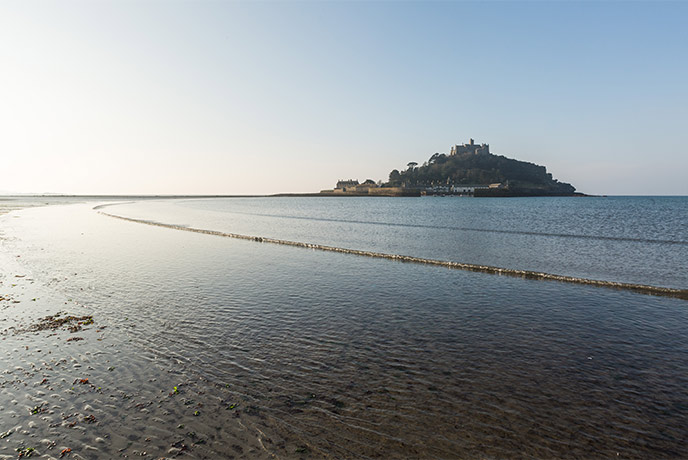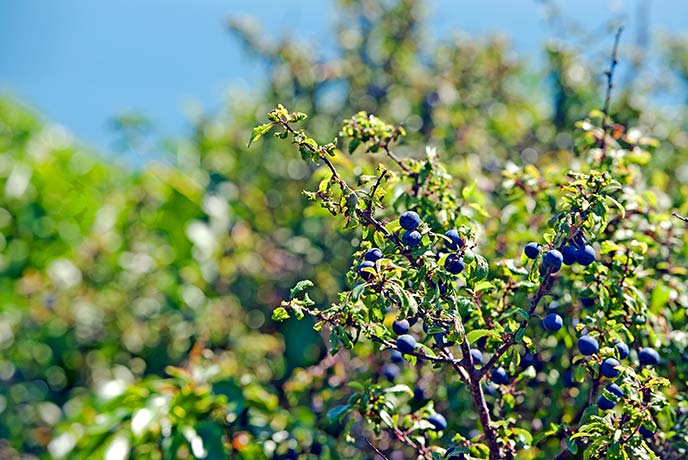The Bronze Age in Cornwall, around 2,500BC, was a time of vibrant activity and scientific and cultural development. A time that is now most famously remembered for the building of enigmatic ceremonial and burial monuments that still lie scattered across the landscape.
These stone and earth constructions required enormous skill, planning and organisation to create, but for our early ancestors it seems that marking their prehistoric world with cairns, barrows, standing stones and stone circles became a vital part of their lives, religion and culture.
Today for our best glimpse into that vanished ancient world you can visit landmarks in some of Cornwall’s wilder, more isolated corners. During the Cornish Bronze Age the largest populations of people were gathered on places like Bodmin Moor, the Lizard Peninsula and West Penwith, and it is in those areas that we can still see our ancestors’ megalithic endeavours and prehistoric villages some 4,000 years later.
So come on a journey with us to some of the most interesting and accessible sites from Cornwall’s ancient past!
Merry Maidens Stone Circle, St Buryan
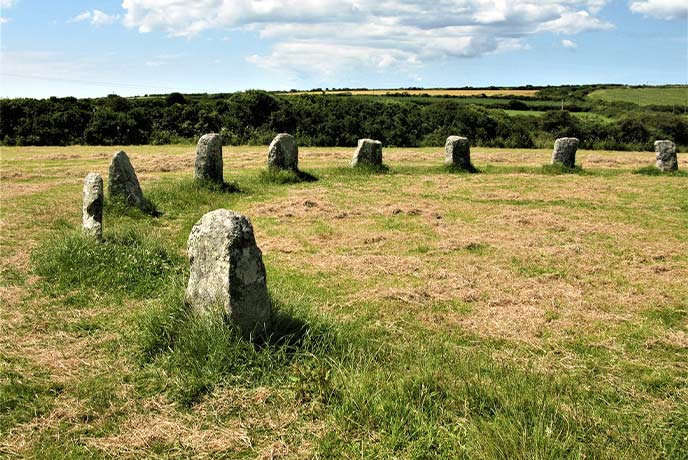
Of all the stone circles in Cornwall, the Merry Maidens, not far from Treen and the open-air Minack Theatre, is one of the most complete and one of the most loved.
Originally known as ‘Dawns Men’ which was a corruption of the Cornish ‘Dons Meyn’ meaning dancing stones, legend has it that these 19 stocky megaliths were in fact girls who were turned to stone for dancing on a Sunday. In an adjacent field you can also see a pair of huge standing stones, the largest in Cornwall, called the Pipers, and further away another called the Blind Fiddler, who are said to be the unfortunate petrified musicians who were providing the tunes for the dancers that day!
Forming a perfect circle some 24m in diameter, these uniform granite stones are all roughly 1m high and were placed here around 4,000 years ago. The real purpose of stone circles is hotly debated, but it is generally agreed that they must have served some kind of ceremonial function and some may have been used to assist with observing the night sky. It also seems likely that they would have been used as meeting places for the community, the ancient equivalent of the marketplace, village green or town hall.
The Merry Maidens’ setting in a field, just off one of the main roads leading to Land’s End, makes it a wonderfully accessible site and a good place to start your exploration of the wilder side of Penwith!
Mên-an-Tol, Madron
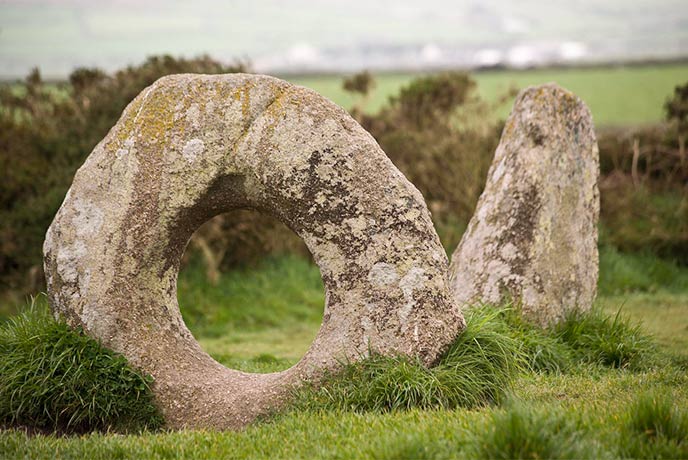
There is no other site in Cornwall, indeed anywhere in the UK, quite like Mên-an-Tol. While this strange arrangement of stones must be one of the most visited Bronze Age sites in the whole of the county, somehow it still retains its mysterious and enigmatic charm.
The unusual donut shaped stone, with a hole big enough for an adult to climb through, is flanked by two upright standing stones and there is another fallen stone nearby. Unfortunately, partly due to its age and the fact that it is thought that the stones may not be in their original positions, it is unclear what Mên-an-Tol was once used for. Some think that it may have formed the entrance to a long since vanished burial chamber or that it was used in fertility rituals, but the truth is that no one really knows, so that leaves the mystery open to your imagination!
This shadowy place in Penwith between Madron and Pendeen also has a number of myths and legends attached to it and the surrounding landscape. It is believed that a battle was fought between the Cornish Prince Rialobran and an unknown invading army not far from the holed stone. The site of this battle is said to be marked by Men Scryfa, an inscribed standing stone you can see in a field close to Mên-an-Tol.
In more recent times however it was thought that passing through the holed stone was a cure for various physical ailments including rickets, back pain and tuberculosis. Like so many ancient stones, Mên-an-Tol also has fertility myths connected to it. It was thought that if a woman passed through the holed stone seven times on a full moon she would be sure to fall pregnant!
Trethevy Quoit, St Cleer
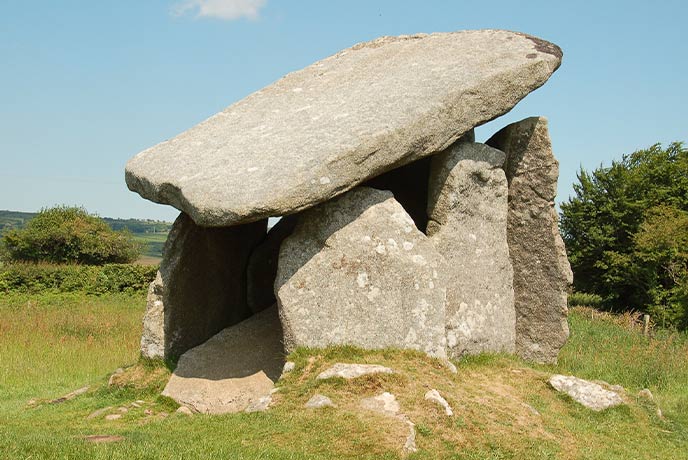
The ancient portal dolman known as Trethevy Quoit has long been considered one of the finest prehistoric monuments in the whole of Cornwall, and unsurprisingly it has been attracting curious visitors for hundreds of years.
Found in the parish of St Cleer, close to the austere heights of Bodmin Moor, it is the only monument of its kind in this region of Cornwall, all the other examples of dolmans (quoits in Cornish) are many miles away on the Penwith Peninsula. Like so many megalithic sites, its sheer scale gave rise to all kinds of legends to explain how it had been constructed. One legend says that the monument was built by the wizard Merlin, who was able to manoeuvre the stones into position using magic, while another suggests that it was the work of a giant, indeed it was known locally as ‘The Giant’s House’.
Alternatively there were those that claimed the quoit marked the site of some ancient battle. In reality, Trethevy is a megalithic masterpiece built around 5,000 years ago and for generations it was used by the local community to hold the funerary remains of their loved ones.
The chamber is truly impressive, formed by six giant granite stones, some as much as 3m high. These are crowned with a massive 4.2m long capstone, which slants at an alarming angle due to one supporting stone collapsing inwards at some time in the past. Another interesting feature to note is the hole in the capstone, there are several theories about how or why this is present, but ultimately no one seems sure whether it is natural or manmade.
Trethevy is known as a ‘portal’ dolman because of the ‘antechamber’ at the front which creates a kind of entrance hall. Inside this is a small aperture which connects to the inner chamber like a tiny door. The Cornish historian William Borlase wrote that during the 18th century people would crawl through this hole to rid themselves of various aches and pains, and children would also be passed through into the chamber in the belief that this could cure them of rickets.
Cornwall Heritage Trust cares for this site today, and it is easy to access from the road and has a small parking area.
Boscawen–Un, St Buryan

In 1928 when the Goresth Kernow, the organisation dedicated to the preservation and promotion of Cornish culture, had its first meeting they decided to hold it at Boscawen-Un, one of the most beautiful and important stone circles in Cornwall.
This Bronze Age monument is special for several reasons, for a start this stone circle is not actually a circle – it’s an oval. The placement of the nineteen stones is thought to follow the course that the moon takes across the night sky. This theory may also connect to one of the circle’s most impressive features, its largest stone. This megalith which sits on the south side of the circle is made from a beautiful solid block of bright white quartz about 4ft high, very different from the grey granite of the other stones. And it is said that this specially selected boulder glows in moonlight.
Another unusual feature of Boscawen-Un is its central stone which leans at quite a dramatic angle. There are theories that this stone may have been disturbed by treasure hunters digging beneath it, but some believe that it was intentionally set at an angle and that it may have been erected on that spot before the circle was built. Recent studies of the surface of this central stone have revealed the outline of a pair of axe heads (or possibly a pair of feet) carved into its underside.
Like the Merry Maidens, Boscawen-Un has been connected to the usual stories of maidens turned to stone for dancing on a Sunday, but some also believe it was also an ancient meeting place for druids hundreds of years after its construction. To this day the circle is used by local pagans and offerings can frequently be found here. Whatever the truth about Boscawen-Un, this is a beautiful site where you can almost feel the layers of history beneath your feet.
You can find Boscawen-Un just off the A30 close to the village of Drift, not far from the popular surfing beach of Sennen in West Cornwall. There is a small layby to park in and a well marked footpath to the site.
Lanyon Quoit, Madron
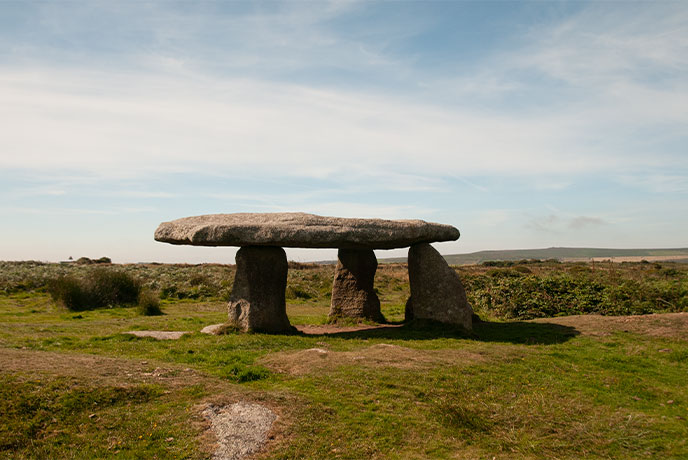
Like Merry Maidens and Men-an-Tol, Lanyon Quoit is very much on the ‘must-see’ list for Penwith. This giant stone table, as it appears today, is what remains of a prehistoric chamber tomb with a mound some 30m long that would once have contained the remains of the dead.
Standing close to the narrow winding road, the monument consists of a huge capstone, 5.3m long, supported on four upright stones, standing about 3m high. The quoit collapsed in 1815 supposedly after a severe gale and was re-erected in 1824 by a man called Captain Giddy, who used a make-shift block and tackle system to manoeuvre the 70 ton capstone into place. It is said that when the monument was rebuilt it wasn’t as high as it had once been, as reputedly a man on horseback was once able to pass through the gap in the stones!
The site is easy to reach, just a couple of miles from the village of Madron and has a small parking area beside the road.
The Hurlers Stone Circles, Minions
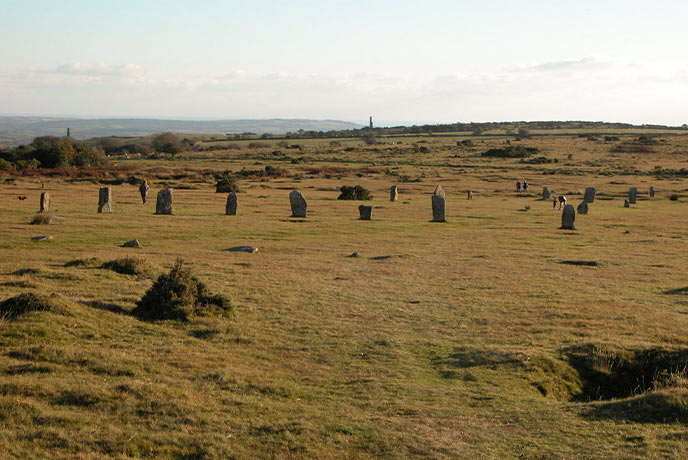
This prehistoric site is completely unique in Cornwall, a set of three Bronze Age stone circles in a row, spread out across the wilds of the moor close to the village of Minions. These incredible remains allow you to really ponder our ancestors’ connections to their landscape and the solar system.
It is thought that the positioning of the Hurlers was intended to allow the builders to keep track of the cosmos in some way, events such as the summer and winter equinoxes perhaps or even the path of the Milky Way across the night sky. It is also thought that the three circles may be an earthly representation of the Orion’s Belt constellation.
The name of the Hurlers comes from an old myth that the stones were the petrified remains of people who were playing the Cornish game of Hurling on a Sunday and were, you guessed it, turned to stone. Hurling is a rough sport, similar to rugby, which involves opposing teams chasing a silver ball, it is still played in St Ives each February and in St Columb on Shrove Tuesday each year.
The northernmost circle of the Hurlers is about 37m across and has 11 upright and four fallen stones, while the middle circle, the best preserved, has 14 stones. The third circle is the most ruinous with only nine out of a possible 28 stones remaining standing. But a walk amongst these ancient remains really is one of the most special in Cornwall, and the surrounding landscape offers other sites to explore too.
In the distance you can see the famous rock formation known as the Cheesewring, while close to the circles is Rillaton Barrow, a burial mound, where in 1837 a group of miners uncovered prehistoric beads, pottery, a dagger and the most incredible gold cup. The cup, known as the Rillaton Cup, dates from the early Bronze Age and is now in the British Museum because it is one of only seven of its kind in the world!
The Hurlers is just outside the village of Minions in North Cornwall and there is a large car park with information boards to help you interpret these amazing stones!
The best of the rest – Off the beaten track
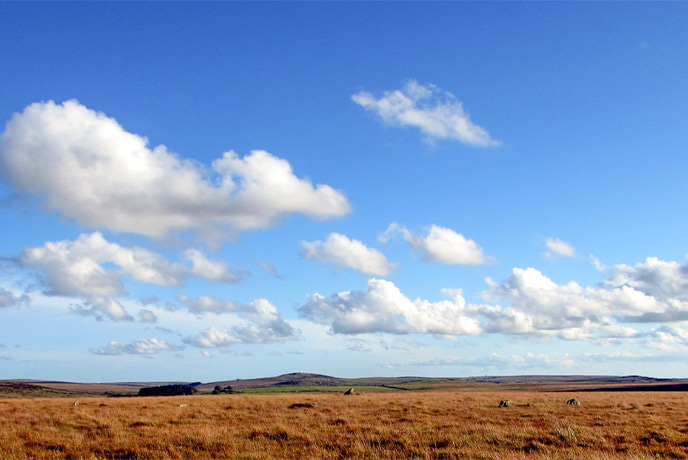
Duloe Stone Circle, 5 miles from Looe – a small circle with huge stones, all made of white quartz.
Tregeseal Stone Circle, St Just – once part of a trio of circles, this is an incredibly peaceful site surrounded by other monuments.
Stannon Stone Circle, Bodmin Moor - an isolated circle of 39 stones surrounded by beautiful moorland.
Fernacre Stone Circle, Bodmin Moor – this atmospheric monument stands in the shadow of Rough Tor.
If these amazing sites have inspired you to get out and explore Cornwall’s ancient past, then discover our collection of welcoming holiday cottages dotted across the county.


